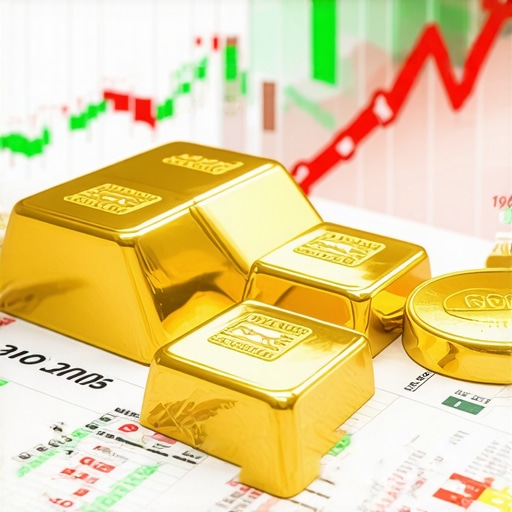Unlocking the Future of Gold Investment: An Expert Analysis of Industry and Mining Trends for 2025
As we approach 2025, investors and industry analysts face a complex landscape of evolving gold industry dynamics and mining trends. Understanding these factors is crucial for making informed decisions that align with long-term wealth preservation and growth. The intersection of geopolitical shifts, technological advancements, and supply-demand fundamentals creates a nuanced environment ripe for strategic investment positioning.
Deciphering Supply-Demand Dynamics in the Gold Market
The core of gold price movements hinges on supply-demand mechanics, where mining output, central bank policies, and consumer demand play pivotal roles. Recent data suggests a potential tightening of supply due to increasing operational costs and regulatory hurdles, which could elevate prices. Meanwhile, demand from sectors such as jewelry, technology, and central bank reserves remains robust, especially amid geopolitical tensions and inflationary pressures.
How Will Mining Industry Innovations Influence 2025 Gold Supply?
Technological innovations, including automation and sustainable practices, are transforming gold mining efficiency. Breakthroughs in deep-earth extraction and environmental compliance can both constrain supply and reduce costs, altering traditional supply curves. The adoption of blockchain for supply chain transparency also adds a layer of credibility and traceability, impacting investor confidence.
Global Economic and Political Factors Shaping Gold Investment
Economic instability, inflation, and currency fluctuations continue to bolster gold’s role as a safe haven. Central banks’ gold purchasing strategies, particularly in emerging markets, are indicative of a long-term shift toward diversification away from fiat currencies. As highlighted by the World Gold Council, these policies significantly influence market prices and investor sentiment (source).
Strategic Approaches for 2025 Gold Investment
Investors should consider a multifaceted approach: combining physical gold holdings, ETFs, and futures contracts. Exploring niche opportunities in gold mining stocks and emerging markets can also diversify portfolios. Advanced traders can leverage technical analysis and market timing strategies detailed in our expert guides.
What Are the Emerging Risks in Gold Industry & Mining for 2025?
Potential risks include regulatory changes, environmental challenges, and geopolitical conflicts disrupting supply chains. The volatility in the crypto sector also poses indirect competition and regulatory scrutiny, impacting gold’s safe-haven status. Keeping abreast of these risks allows for proactive portfolio adjustment.
For those seeking a comprehensive understanding of market forecasts, exploring our 2025 gold price forecasts is highly recommended. Sharing insights with fellow investors and industry experts can further refine your strategic positioning in this dynamic environment.
Can Technological Breakthroughs Secure a More Stable Gold Supply in 2025?
As the gold industry advances, the integration of cutting-edge technologies such as automation, artificial intelligence, and environmental sustainability practices is transforming how gold is mined and supplied. These innovations are not merely operational upgrades; they fundamentally influence the supply chain’s resilience and cost structure, which, in turn, impacts gold prices.
Recent developments in deep-earth extraction techniques have enabled miners to access previously unreachable deposits, potentially boosting supply. Simultaneously, the adoption of eco-friendly mining practices, driven by stricter regulations and societal expectations, is encouraging companies to innovate rather than expand supply indiscriminately. This balance of supply enhancement and sustainability is crucial for maintaining price stability amid fluctuating demand.
Blockchain technology also plays a vital role by improving supply chain transparency and traceability, which enhances investor confidence and reduces the risks of fraud or unethical sourcing. These advancements collectively promote a more predictable and trustworthy gold market, enabling investors to better anticipate supply-side movements and integrate them into their strategic planning.
What Are the Practical Implications for Investors Navigating Supply Risks in 2025?
Investors should consider diversifying their portfolios with exposure to innovative mining firms and environmentally responsible producers. Staying informed about technological trends and regulatory changes—such as stricter environmental standards—can help in assessing supply risks effectively. For a comprehensive understanding, exploring detailed industry impact analyses is highly recommended.
Moreover, engaging with expert insights on upcoming supply constraints or breakthroughs can provide a competitive edge. As the industry evolves, the ability to differentiate between sustainable growth companies and those facing operational hurdles will be vital for long-term wealth preservation and growth.
To deepen your knowledge of how supply-side innovations will influence the gold market, consider reviewing our market analysis resources. Sharing your thoughts or questions in the comments could spark valuable discussions among fellow investors and industry professionals.
Harnessing Cutting-Edge Technologies to Mitigate Gold Supply Risks in 2025
As we delve deeper into the technological revolution transforming the gold mining landscape, one cannot ignore the profound impact of innovations such as artificial intelligence (AI), machine learning, and advanced automation systems. These tools are not only streamlining operations but also addressing critical challenges like resource depletion, environmental compliance, and operational safety, which are pivotal in maintaining a stable gold supply chain.
For instance, AI-driven exploration algorithms analyze vast geospatial datasets to identify promising deposits with unprecedented accuracy. According to a 2024 report by the Mining Innovation Institute, such algorithms have increased discovery rates by up to 35%, significantly expanding the global resource base. This technological leap allows miners to optimize extraction schedules, reduce waste, and enhance the overall efficiency of resource utilization, thereby stabilizing supply parameters.
Simultaneously, automation and robotics are revolutionizing extraction processes. Autonomous drilling rigs and robotic underground loaders minimize the need for human presence in hazardous environments, reducing costs and improving safety standards. These advancements enable continuous operations even in challenging conditions, which historically led to supply disruptions. The integration of IoT sensors further facilitates real-time monitoring of equipment health, predictive maintenance, and swift response to operational anomalies.

Environmental Sustainability as a Catalyst for Supply Chain Resilience
Another dimension of technological innovation lies in sustainable mining practices. Companies adopting eco-friendly methods, such as in-situ leaching and bio-mining, are not only reducing environmental impact but also ensuring compliance with increasingly stringent regulations. These practices extend the operational lifespan of mining sites and prevent supply interruptions caused by environmental conflicts or regulatory shutdowns.
Blockchain technology complements these efforts by enhancing transparency and traceability in the supply chain. Certified supply chain data assures investors and consumers of ethically sourced gold, fostering trust and stability in the market. A notable example is the GoldChain platform, which has successfully traced over 1,000 tons of legally compliant gold from mine to market, significantly reducing the risk of illicit sourcing.
What strategic measures can investors adopt to leverage technological advancements for a more resilient gold portfolio?
Investors should prioritize exposure to companies at the forefront of technological innovation, particularly those integrating AI, automation, and sustainable practices. Diversification into funds focused on environmentally responsible mining firms can also mitigate risks associated with regulatory changes or operational disruptions. Monitoring industry reports, such as those from the World Gold Council, provides valuable insights into emerging trends and technological breakthroughs shaping the future of gold supply.
To deepen your understanding of how technology is transforming gold mining and supply stability, explore our detailed comprehensive analysis and join discussions with industry experts who are pioneering these innovations. Staying informed and adaptive is key to capitalizing on the opportunities presented by these technological advancements.
Transforming Gold Mining with Cutting-Edge Innovations: A Deep Dive into 2025 Supply Security
As the gold industry embraces a technological renaissance, the integration of artificial intelligence, machine learning, and robotics promises to revolutionize supply chain resilience. These advancements not only streamline operations but also address critical challenges such as resource depletion, environmental compliance, and operational safety, which are vital for maintaining a stable and predictable gold supply in 2025.
Recent breakthroughs in geospatial data analysis, driven by AI algorithms, have dramatically increased the accuracy of resource discovery. According to a 2024 report by the Mining Innovation Institute, these technologies have elevated discovery success rates by up to 35%, expanding the global resource base and reducing exploration costs. This enables miners to optimize extraction schedules, minimize waste, and enhance operational efficiency, directly impacting supply stability and price predictability.
Automation and robotics are transforming extraction processes by deploying autonomous drilling rigs and underground loaders. These technologies reduce human risk, lower operational costs, and facilitate continuous mining in challenging environments, which historically caused supply interruptions. Furthermore, IoT sensors enable real-time equipment monitoring, predictive maintenance, and swift anomaly detection, ensuring uninterrupted operations and supply continuity.

Enhancing Supply Chain Transparency through Blockchain Technology
Blockchain’s role in fostering supply chain transparency and traceability cannot be overstated. Platforms like GoldChain have effectively traced over 1,000 tons of legally compliant gold, certifying its ethical sourcing from mine to market. This transparency reduces risks associated with illicit sourcing, bolsters investor confidence, and aligns with increasing regulatory demands for responsible mining practices.
These innovations collectively foster a more resilient supply chain, capable of withstanding geopolitical tensions, environmental regulations, and market fluctuations. Investors who prioritize exposure to companies pioneering these technologies will be better positioned to capitalize on the stability and growth potential of the gold market in 2025.
What strategic measures can investors adopt to leverage technological advancements for a more resilient gold portfolio?
Investors should focus on diversifying their holdings by including technologically innovative mining firms and environmentally responsible producers. Monitoring industry reports from authoritative sources like the World Gold Council provides insights into emerging trends and breakthroughs. Engaging with expert analyses and staying informed about regulatory developments will enable proactive portfolio adjustments, mitigating risks associated with technological obsolescence or regulatory shifts.
Explore our comprehensive analysis to understand how technological progress is shaping supply stability, and participate in industry discussions to refine your strategic approach. Staying ahead of these innovations is essential for maximizing returns and safeguarding long-term wealth in the evolving landscape of gold investment.
Expert Insights & Advanced Considerations
1. The integration of AI and automation is transforming gold mining efficiency, reducing supply disruptions and stabilizing prices.
Advanced technologies like AI-driven exploration and autonomous extraction are enabling miners to discover deposits with greater accuracy and operate continuously in challenging environments, ensuring a more resilient supply chain for 2025.
2. Environmental sustainability practices, including bio-mining and in-situ leaching, are not only reducing ecological impacts but also extending the operational lifespan of mining sites, thus supporting supply stability.
Adopting eco-friendly methods aligns with stricter regulations and societal expectations, mitigating risks of supply interruptions from environmental conflicts or regulatory shutdowns.
3. Blockchain technology enhances transparency and traceability, reducing the risks associated with illicit sourcing and fostering investor confidence in ethically sourced gold.
Platforms like GoldChain exemplify how digital traceability builds trust and stability in the market, crucial for strategic investment decisions in 2025.
4. Diversifying into technologically innovative and environmentally responsible mining firms offers a strategic advantage, aligning with future supply chain resilience and growth opportunities.
Monitoring industry reports and technological breakthroughs, such as those from the World Gold Council, helps investors stay ahead in this evolving landscape.
5. Staying informed about regulatory developments, technological advancements, and market dynamics is essential for proactive portfolio management and risk mitigation in the gold sector.
Engaging with industry analyses and expert insights ensures that investors can adapt strategies effectively, maximizing opportunities and safeguarding assets.
Curated Expert Resources
- World Gold Council: Offers comprehensive reports on industry trends, technological innovations, and market forecasts, serving as an authoritative source for strategic insights.
- Mining Innovation Institute: Provides cutting-edge research on AI, automation, and sustainable practices transforming the mining sector, essential for understanding technological impacts on supply.
- GoldChain Platform: Demonstrates blockchain’s role in supply chain transparency, showcasing real-world applications that enhance trust and ethical sourcing.
- Industry Reports & Market Analysis: Regular publications from leading financial and industry analysts offer nuanced perspectives on regulatory, geopolitical, and economic influences shaping gold markets.
Final Expert Perspective
The future of gold investment in 2025 hinges on the strategic integration of technological innovation, environmental responsibility, and transparency. As supply chains become more resilient through AI, automation, and blockchain, investors who prioritize these trends will be better positioned for stability and growth. Embracing these advanced insights and leveraging authoritative resources will be key to navigating the complexities of this dynamic market. Engage with industry leaders, contribute your expertise, and explore tailored strategies that align with the evolving landscape—your proactive involvement is essential in shaping a resilient and prosperous gold investment future.










